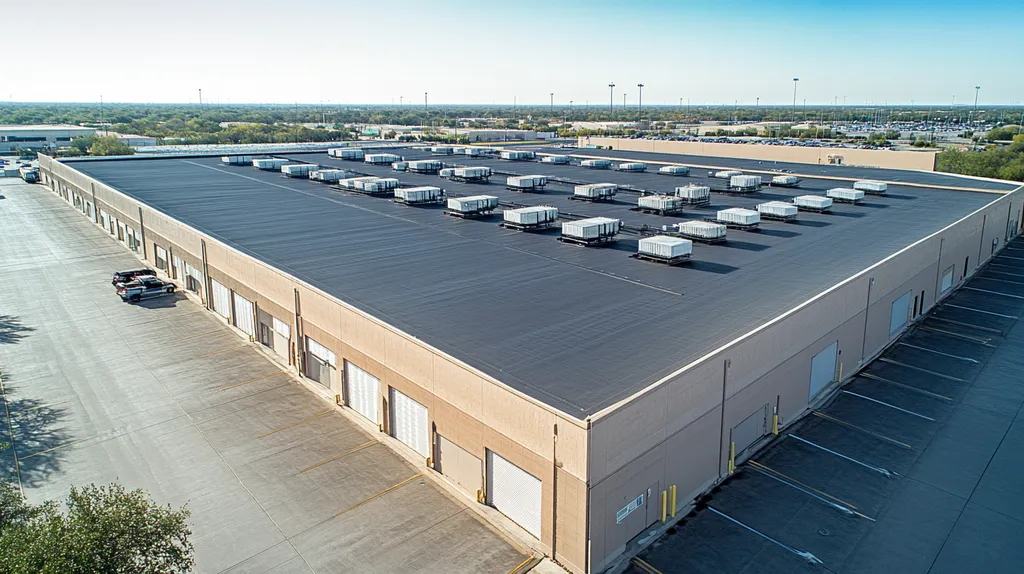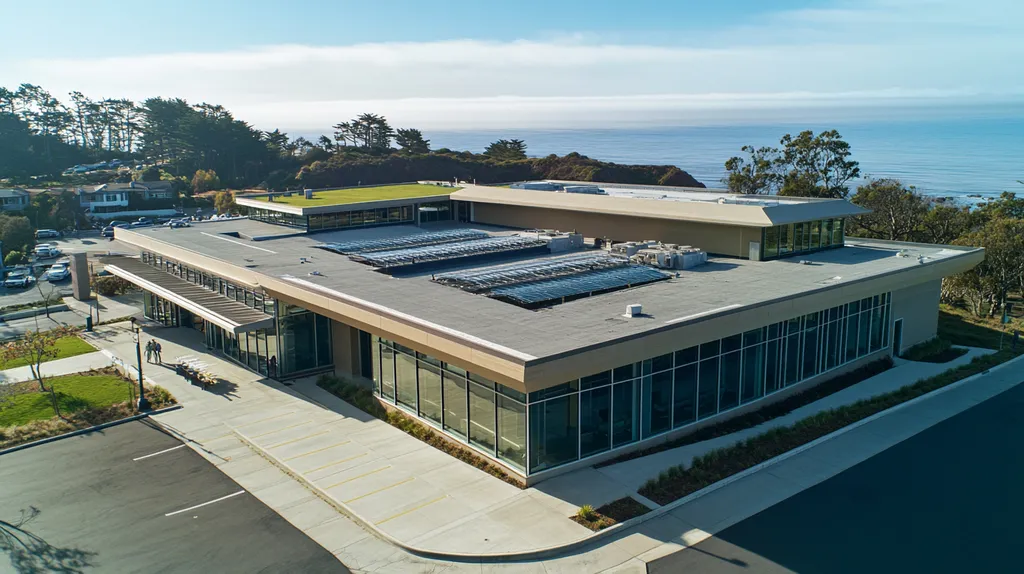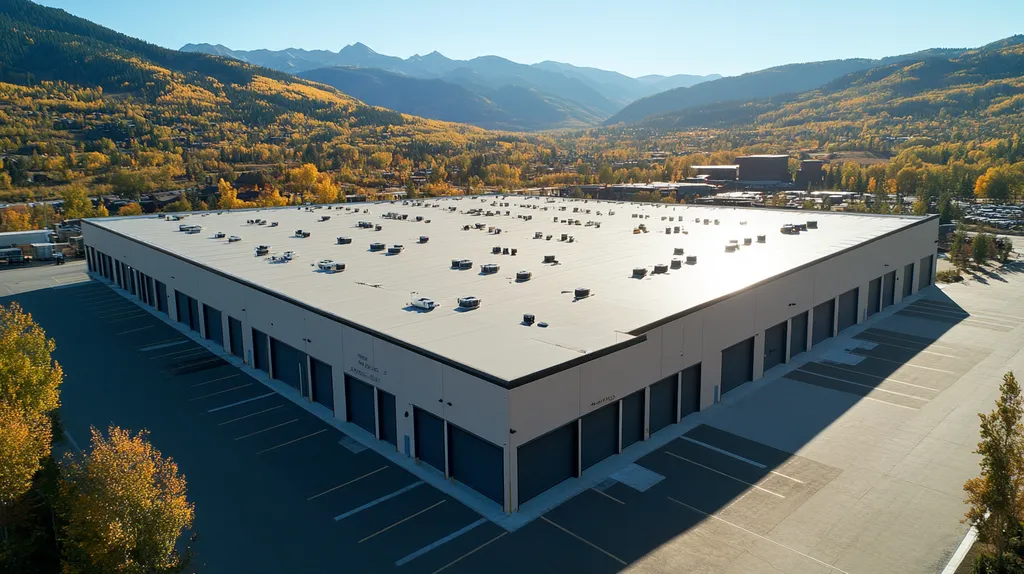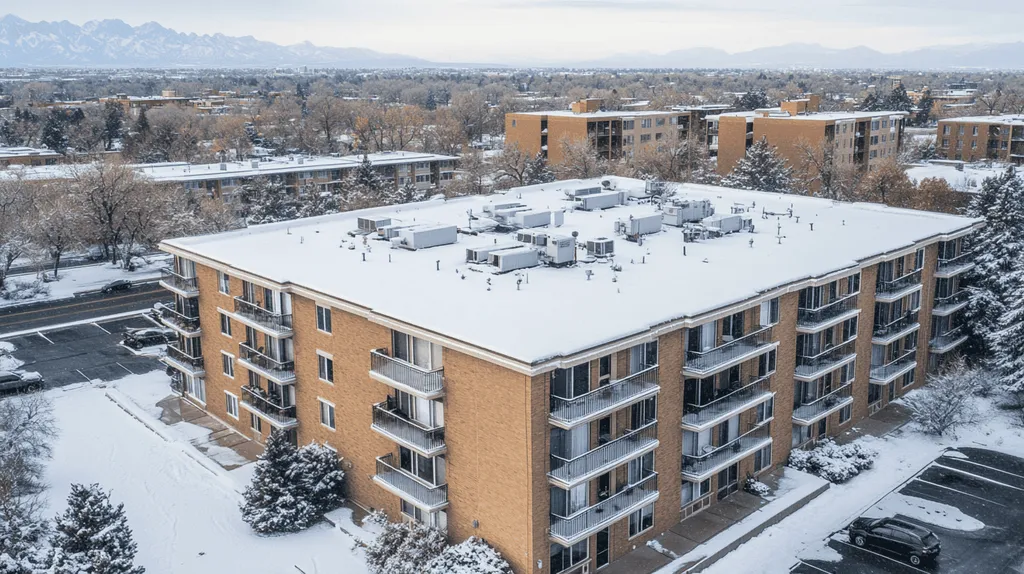In 2023, commercial roofing violations resulted in over $12 million in OSHA penalties, highlighting the severe consequences of regulatory non-compliance. Property owners face escalating fines, insurance complications, and potential business disruptions when roofing regulations are overlooked.
From fall protection requirements to proper documentation protocols, understanding and following commercial roofing regulations has become increasingly critical for facility managers and property owners.
This comprehensive guide examines the key compliance areas, financial implications, and practical solutions to help professionals navigate regulatory requirements while protecting their investments and workforce safety.
SECTION 1: PERFORMANCE FACTORS
Understanding and adhering to commercial roofing regulations is vital for ensuring the safety of workers and protecting valuable assets. In 2021, the Occupational Safety and Health Administration (OSHA) recorded over 1,000 fall-related injuries in the construction industry, highlighting the significant dangers involved. Non-compliance leads to not only substantial fines and legal issues but also creates an unsafe environment for property managers and their staff. This section outlines essential performance factors that directly influence regulatory compliance and workplace safety.
Fall Protection Compliance
Implementing effective fall protection measures is crucial in commercial roofing. OSHA requires employers to establish fall prevention systems whenever work occurs at heights exceeding six feet. Ignoring these mandates can result in fines as steep as $13,653 for each violation.
Property owners should routinely evaluate their fall protection strategies to ensure they align with current standards. This includes integrating guardrails, safety nets, and personal fall arrest systems into their safety plans.
A robust fall protection plan not only meets legal requirements but also cultivates a culture of safety and compliance among workers. This proactive approach can lead to fewer workplace accidents and improved operational efficiency, proving that prevention is more cost-effective than managing the fallout from fall-related incidents.
Key Action Items
Ladder and Scaffold Safety
Ladders and scaffolds are indispensable in commercial roofing, but they come with inherent risks that must be proactively managed. OSHA regulations require routine inspections of ladders and only permit their use for designated purposes. Ignoring these guidelines can lead to severe accidents and heightened financial liability.
Facilities managers are responsible for ensuring scaffolding is set up by qualified personnel and complies with specified load-bearing limits. Neglecting these protocols can lead to catastrophic collapses, compromising both worker safety and financial stability.
Committing to ladder and scaffold safety reinforces compliance efforts while creating a more secure work environment. Property managers can enhance safety awareness through regular training sessions and updates on best practices.
Key Action Items
Roof Edge Hazard Mitigation
The edges of commercial roofs pose significant risks and must be strategically safeguarded. Implementing edge protection systems is essential for preventing falls, as OSHA mandates safety measures at these high-risk points to avoid serious injuries.
Effective protective solutions, such as parapets or guardrails, can greatly reduce these hazards and ensure worker safety on-site. Regular inspections of roof edges help maintain compliance with regulations and identify emerging risks.
Facilities managers should prioritize roof edge safety, as neglecting these measures can lead to devastating accidents and substantial financial repercussions. Maintaining compliance not only protects workers but also safeguards the property’s reputation in the industry.
Key Action Items
SECTION 2: FINANCIAL CONSIDERATIONS
The financial implications of neglecting commercial roofing regulations can spiral out of control, jeopardizing not only financial stability but also operational integrity. Compliance violations may result in fines that range from hundreds to thousands of dollars, creating budgetary chaos. Property owners must grasp the entirety of potential financial repercussions, from immediate penalties to long-term costs resulting from neglect.
Penalty Assessment and Fines
Overlooking roofing regulations can trigger severe compliance penalties. Both local and federal guidelines impose fines that can quickly drain a property owner’s budget. For instance, failure to obtain necessary building permits might result in fines soaring to several thousand dollars for each violation, with daily penalties adding to the cost (source: Bradford Miller Law).
Moreover, repeat violations might incur escalating penalties, compounding financial pressure over time. Some local governments even flag non-compliant properties for heightened scrutiny, which can tarnish a property’s reputation and hinder future projects.
Timely compliance is essential to steer clear of these financial drawbacks. A proactive approach ensures roofing projects meet all necessary codes and regulations from the start, saving property managers from costly fines.
Key Action Items
Insurance and Liability Costs
Neglecting roofing regulations can lead to higher insurance premiums and increased liability costs. Insurance providers often assess compliance status when calculating rates; properties with ongoing violations tend to be classified as high-risk, leading to significant premium hikes.
If an unapproved roofing installation fails, the resulting claims can be exorbitant. Often, insurance may not cover damages from unauthorized work, leaving the financial burden solely on the property owner. For instance, a roof failure can result in expensive repairs and loss of income due to operational disruptions.
To mitigate unexpected expenses, property owners should routinely review their insurance policies and ensure compliance requirements are met. This proactive step helps maintain manageable insurance costs and avoids financial pitfalls.
Key Action Items
Long-Term Cost Implications
Ignoring roofing regulations can result in substantial long-term financial consequences. Non-compliant roofs often sustain premature failures, necessitating costly replacements much earlier than compliant counterparts.
The costs associated with fixing such failures can quickly surpass any initial savings gained from bypassing regulations. For instance, a roof that collapses due to improper installation may require complete replacement within just a few years.
Additionally, properties with non-compliant roofing may face inflated operational costs due to increased energy inefficiency. Poor thermal performance could substantially elevate heating and cooling expenses, straining budgets further.
Conversely, investing in compliant roofing systems can yield long-term benefits in terms of durability and efficiency. Prioritizing compliance is essential for a sustainable and cost-effective approach to property management.
Key Action Items
SECTION 3: COMPLIANCE REQUIREMENTS
In the world of commercial and industrial roofing, regulatory compliance is crucial—not just for legal adherence but for protecting lives and investments. Non-compliance can lead to severe penalties, with fines reaching as high as $16,131 per violation beginning in January 2024. Understanding and implementing the right regulations is essential to prevent costly repercussions and ensure a safe workplace. This section delves into the core compliance requirements set by OSHA, the importance of inspections, and the necessity of proper documentation.
OSHA Regulations and Standards
The Occupational Safety and Health Administration (OSHA) establishes vital regulations for roofing activities, designed to ensure safety on commercial and industrial job sites. These regulations address key areas like fall protection, safe material handling, and the proper use of equipment. For instance, OSHA requires that all workers on roofs higher than six feet utilize appropriate fall protection systems.
Being informed about these regulations is critical. Non-compliance can result in not just fines but also project disruptions and heightened insurance costs. Property owners risk their reputation as they may struggle to secure coverage for unsafe practices.
Staying current with OSHA’s evolving guidelines can be challenging but is necessary. Conducting regular training sessions and safety audits can significantly improve a team’s understanding of these regulations. Collaborating with knowledgeable roofing contractors can also ensure effective compliance measures are in place.
Key Action Items
Inspection and Citation Process
The inspection and citation process is pivotal for ensuring roofing compliance. OSHA conducts inspections triggered by various factors, including complaints, referrals, or scheduled inspections. When violations are discovered, citations are issued, often leading to fines and required corrective measures.
Being prepared for inspections is essential for property owners. This involves maintaining a clean, organized work site and confirming that all materials and safety protocols meet the required standards. A well-maintained site reflects a commitment to safety, positively impacting inspectors’ assessments.
Understanding the citation process is also crucial. Citations may vary in severity and come with deadlines for compliance. Addressing these citations promptly is vital to avoid escalating penalties and project delays, which can strain financial resources.
Key Action Items
Compliance Documentation and Records
Maintaining reliable documentation is essential for demonstrating compliance with roofing regulations. Property owners should keep detailed records of safety training sessions, inspection reports, and incident logs as these documents provide evidence of commitment to safety standards.
In the event of an OSHA inspection, thorough documentation can drastically reduce fines and show diligence in adhering to regulations. In contrast, poor records can lead to substantial penalties and complicate any appeals.
Implementing an effective documentation strategy, including digital tools for easy tracking, can improve access to essential records during inspections and ensure all compliance measures are current. Cultivating a culture of compliance encourages safety among employees and leads to fewer risks.
Key Action Items
SECTION 4: RISK MANAGEMENT
Neglecting commercial roofing regulations poses substantial risks that can impact both financial and operational stability. Fines, legal repercussions, and safety hazards are just the tip of the iceberg. In fact, about 30% of roofing-related lawsuits arise from issues like failed inspections or incorrect permits. To navigate these challenges effectively, property managers must prioritize risk management by identifying hazards, implementing robust safety protocols, and fostering employee training.
Identifying and Assessing Hazards
The first crucial step in effective risk management involves pinpointing potential hazards encountered in commercial roofing. These hazards may encompass structural weaknesses such as compromised decking or environmental risks including falling debris. Property owners should engage in regular inspections to accurately evaluate their roofs’ conditions.
Employing advanced technology, like drones or thermal imaging, can help detect hidden weaknesses that aren’t visible to the naked eye. For instance, moisture collection can become a critical issue if overlooked. An inadequate assessment heightens the risk of failing inspections, ultimately leading to penalties.
Additionally, enlisting the expertise of seasoned roofing professionals can reveal latent dangers. Their knowledge not only identifies existing risks but also ensures proactive measures are taken to prevent future compliance violations.
Key Action Items
Implementing Safety Protocols
Establishing well-defined safety protocols is essential for minimizing risks on the job site. These protocols should cover all aspects of roofing operations, including installation and ongoing maintenance. A thorough set of procedures can greatly decrease the chance of accidents while ensuring regulatory compliance.
For example, creating designated safety zones and mandating proper equipment usage can significantly reduce risks during maintenance tasks. It’s also vital to regularly update these protocols to align with industry best practices and emerging regulations.
Periodic reviews of safety protocols lend insight into areas requiring improvement and help maintain compliance standards. Conducting audits not only verifies adherence but also highlights any lapses that need immediate attention, reinforcing a culture of safety.
Key Action Items
Employee Training and Awareness
Effective risk management is incomplete without comprehensive employee training. Ensuring all staff understand regulatory requirements and safety practices strengthens overall compliance efforts. Regular training sessions can enhance knowledge and improve team morale significantly.
For example, hosting workshops on fall protection and safe material handling can greatly reduce workplace injuries. Keeping employees informed on recent regulatory updates will further bolster vigilance.
Building awareness cultivates a sense of responsibility among workers, inspiring them to report hazards promptly. By establishing clear reporting protocols, potential risks can be addressed efficiently, preventing accidents before they occur.
Key Action Items
SECTION 5: OPERATIONAL PROCEDURES
Implementing effective operational procedures is crucial for managing the risks associated with commercial roofing regulations. Neglecting to adopt strong processes can lead to serious legal and financial consequences, including hefty penalties and costly repairs. For instance, companies that fail to comply with safety regulations can face fines averaging in the thousands of dollars. By establishing clear pre-work safety checks, continuous on-site monitoring, and systematic incident reporting, property managers can significantly reduce these risks and ensure full compliance.
Pre-Work Safety Checks
Pre-work safety checks are the cornerstone of a successful roofing project, setting the stage for both safety and compliance. Property managers must ensure that all equipment is inspected and that materials adhere to regulatory standards, as failing to do so can lead to accidents and non-compliance penalties.
Before commencing any work, creating a thorough checklist is essential. This checklist should cover the integrity and compliance of items like ladders, scaffolding, and personal protective equipment (PPE). Regular audits of these preparations can help avoid unforeseen delays and costs.
Furthermore, it’s vital to ensure that all workers are well-versed in safety protocols specific to the roofing site. An informed crew is better equipped to prevent accidents that could trigger costly penalties. Documenting pre-work checks also provides critical proof of compliance during inspections.
Key Action Items
On-Site Safety Monitoring
Continuous safety monitoring during the roofing project is vital for both compliance and protecting workers. Regular evaluations help identify and address risks before they escalate into accidents or lead to penalties. Research shows that effective monitoring can result in a 50% reduction in job-related accidents.
Assigning a dedicated safety officer to the site enhances adherence to safety regulations. This individual should focus on overseeing safety practices and swiftly addressing any potential violations. Their role acts as a strong deterrent against unsafe behaviors.
Incorporating technology, such as drones or surveillance cameras, into monitoring efforts can also provide a comprehensive view of safety measures. These tools allow property managers to conduct virtual inspections without disrupting ongoing work. A culture of transparency and open communication among crew members further reinforces safety, making regular meetings essential for discussing safety protocols.
Key Action Items
Incident Reporting and Response
Establishing an efficient incident reporting and response protocol is crucial for managing unexpected events. Swift reporting minimizes damage and reduces the likelihood of penalties. Industry standards dictate that timely communication plays a significant role in how regulatory bodies respond to incidents.
Roofing teams should be trained to recognize and report incidents immediately, including near misses, which offer valuable lessons for improving safety. Proper documentation of all incidents is essential for regulatory inspections and future risk mitigation efforts.
Furthermore, having a clear action plan for responding to incidents ensures that steps are in place to address safety violations and apply preventive measures afterward. Taking prompt action demonstrates a commitment to safety and regulatory compliance. Regularly reviewing incident reports can help refine safety protocols and align them with current regulations.
Key Action Items
SECTION 5: OPERATIONAL PROCEDURES
Effective operational procedures are essential for managing the risks associated with commercial roofing regulations. Failing to implement strong processes can lead to serious legal and financial consequences, including hefty fines and repair costs. For instance, companies ignoring safety regulations face fines averaging thousands of dollars. By establishing clear pre-work safety checks, ongoing site monitoring, and efficient incident reporting, property managers can significantly reduce these risks and ensure full compliance.
Pre-Work Safety Checks
Pre-work safety checks lay the foundation for any successful roofing project. It is vital for property managers to ensure all equipment is inspected and that materials meet regulatory standards, as neglecting these checks can lead to accidents and hefty penalties.
Before any roofing activity begins, creating a comprehensive checklist is essential. This checklist should include verifying the integrity and compliance of ladders, scaffolding, and personal protective equipment (PPE). Regular audits of these preparations can help prevent unforeseen delays and expenses.
Property owners must also ensure that all workers are trained on specific safety protocols. Familiarizing crew members with safety hazards unique to the roofing site equips them to avoid accidents that could lead to costly violations. Documenting pre-work checks serves as proof of compliance during inspections, adding an extra layer of protection against fines.
Key Action Items
On-Site Safety Monitoring
Continuous safety monitoring throughout the roofing project is vital for compliance and protecting workers. Regular assessments help identify risks before they escalate into accidents or lead to penalties. Research shows that effective monitoring can reduce job-related accidents by 50%.
Assigning a dedicated safety officer to the site enhances adherence to safety regulations. This individual oversees safety practices and quickly addresses potential violations, serving as a crucial deterrent against unsafe behaviors.
Incorporating advanced technology, such as drones or surveillance cameras, further improves monitoring efforts. These tools allow property managers to perform virtual inspections, ensuring compliance without disrupting ongoing work. Fostering transparency and communication among crew members is also key; regular meetings reinforce safety protocols and promote a proactive approach to identifying risks.
Key Action Items
Incident Reporting and Response
Establishing a clear incident reporting and response protocol is essential for managing unexpected events. Swift reporting minimizes damage and reduces the risk of penalties. Timely communication is critical, as it impacts how regulatory bodies respond to incidents.
Every roofing team should be trained to recognize and report incidents immediately, including near misses, which provide valuable lessons for improving safety. Proper documentation of incidents is vital for regulatory inspections and future risk mitigation efforts.
Having a structured action plan for responding to incidents ensures that safety violations are addressed promptly and preventive measures are implemented afterward. Taking proactive steps demonstrates a commitment to safety and compliance. Regularly reviewing incident reports helps refine safety protocols, keeping roofing operations aligned with current regulations.
Key Action Items
The Bottom Line
With OSHA penalties for roofing violations exceeding $12 million in 2023, the financial stakes for regulatory compliance have never been higher.
Property owners face escalating challenges beyond direct fines, including insurance premium hikes of up to 300% and potential business interruption costs averaging $5,000 per day.
Success in navigating these regulations requires a three-pronged approach: implementing comprehensive safety protocols, maintaining detailed documentation, and conducting regular training programs.
The investment in compliance today protects not only against immediate penalties but also ensures long-term operational sustainability and worker safety.
As regulatory oversight continues to intensify, property owners who prioritize roofing compliance position themselves for reduced liability and enhanced property value protection.
FREQUENTLY ASKED QUESTIONS
Q. Why are commercial roof regulations important for safety?
A. Adhering to regulations ensures the safety of workers by reducing fall risks and hazards. Inadequate compliance can lead to severe injuries or fatalities, jeopardizing lives and the property’s integrity. Implementing prescribed safety measures fosters a culture of compliance, ultimately protecting both workers and assets.
Q. What financial penalties can arise from ignoring industrial roof regulations?
A. Non-compliance can lead to fines ranging from hundreds to thousands of dollars, causing budget stress. Additionally, properties with violations may incur rising insurance premiums as they are deemed high-risk, increasing overall financial strain due to ongoing compliance issues.
Q. What are the core compliance requirements for commercial roofing?
A. Core requirements include obeying OSHA regulations, proper safety training, and maintaining accurate records. Having effective measures in place helps avoid costly fines and creates a safer roofing environment, ensuring worker safety and project feasibility by meeting legal standards.
Q. How can hazards be identified in commercial roofing?
A. Hazards can be identified through routine inspections and risk assessments that evaluate structural and environmental factors. Utilizing technology such as drones for inspections can reveal hidden issues, while engaging experienced roofing professionals can enhance hazard identification and compliance strategy effectiveness.
Q. What steps should be included in pre-work safety checks for roofing?
A. Pre-work checks should confirm the integrity of ladders, scaffolding, and PPE compliance. Each member of the crew should review safety protocols specific to the site to prevent accidents. Documenting these checks also provides critical proof for compliance during inspections, enhancing safety culture.
Q. Why is effective incident reporting crucial in industrial roofing?
A. Efficient incident reporting helps manage unexpected events swiftly, reducing potential damage and minimizing penalties. It is vital for regulatory inspections, as documented incidents inform future risk mitigation strategies, showcasing commitment to safety and compliance processes across roofing operations.
Q. What is the role of employee training in roofing compliance?
A. Employee training is essential for ensuring staff understands regulations, safety measures, and compliance protocols. Regular training sessions boost morale and create awareness, prompting team members to report hazards efficiently, which also fosters a proactive culture committed to workplace safety.











